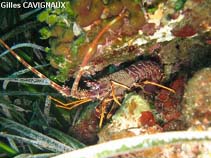Palinurus elephas (Fabricius, 1787)
Common spiny lobster| Native range | All suitable habitat | Point map | Year 2050 |

|
| This map was computer-generated and has not yet been reviewed. |
| Palinurus elephas AquaMaps Data sources: GBIF OBIS |
Classification / Names Common names | Synonyms | CoL | ITIS | WoRMS
| Decapoda | Palinuridae
Environment: milieu / climate zone / depth range / distribution range Ökologie
; tiefenbereich 5 - 200 m (Ref. 85369), usually 10 - 70 m (Ref. 4). Subtropical; 12°C - 16°C (Ref. 114562), preferred 11°C (Ref. 107945); 61°N - 27°N, 32°W - 36°E (Ref. 114562)
Verbreitung Länder | FAO Gebiete | Ecosystems | Vorkommen | Einführungen
Eastern Atlantic and the Mediterranean: from Norway to Morocco. Subtropical to temperate.
Length at first maturity / Size / Gewicht / Alter
Maturity: Lm 10.0, range 7 - 8 cm Max length : 50.0 cm TL Männchen/unbestimmt; (Ref. 441); common length : 40.0 cm BASL Männchen/unbestimmt; (Ref. 441); max. veröff. Alter: 15 Jahre (Ref. 85318)
Traditionally caught by traps, pots and sometimes by hand (e.g., diving and spearing; Refs. 441, 85369), but these gears were eventually replaced with trammel nets (Ref. 85369). Minimum depth from Ref. 4. Occurs at depths between shore to 200 m, on rocky bottoms and coralligenous substrates where there are lots of protective holes and micro-caves. Adults may be solitary, in pairs or in small groups. Highly omnivorous and preys on hard-shelled bottom dwelling organisms, i.e., mollusks, echinoderms and crustaceans. They are generalists and opportunistic feeders depending on the abundance of benthic organisms (Ref. 85369). Ovigerous females are observed from September to October and February to March (Ref. 4).
Life cycle and mating behavior Geschlechtsreife | Fortpflanzung | Ablaichen | Eier | Fecundity | Larven
Breeds once a year between June and October. Larger females mate and lay eggs earlier during breeding season while smaller females spawn towards the end (Ref. 85364).
Hauptreferenz
Referenzen | Koordinator | Partner
Holthuis, L.B. 1991. (Ref. 4)
IUCN Rote Liste Status (Ref. 130435)
gefährdet, siehe IUCN Red List (VU) (A2bd); Date assessed: 26 September 2013
CITES Status (Ref. 108899)
Not Evaluated
CMS (Ref. 116361)
Not Evaluated
Bedrohung für Menschen
Nutzung durch Menschen
Fischereien: kommerziell
FAO - Fischereien: landings | FishSource | Sea Around Us
Tools
Mehr Information
Internet Quellen
BHL | BOLD Systems | CISTI | DiscoverLife | FAO(Fischereien: ; publication : search) | Fishipedia | GenBank (Genom, nucleotide) | GloBI | Gomexsi | Google Books | Google Scholar | Google | PubMed | Tree of Life | Wikipedia (Gehe zu, Suchen) | Zoological Record
Estimates based on models
Preferred temperature
(Ref. 115969): 7.7 - 19.6, mean 11.9 (based on 808 cells).
Widerstandsfähigkeit
(Ref. 69278):
mittel, Verdopplung der Population dauert 1,4 - 4,4 Jahre. (K=0.13-0.21; tm=4; tmax=15).
Prior r = 0.22, 95% CL = 0.14 - 0.33, Based on 4 data-limited stock assessments.
Nutrients: Calcium = 109 [35, 184] mg/100g; Iron = 1.59 [1.21, 1.97] mg/100g; Protein = 20.2 [19.2, 21.3] %; Omega3 = 0.285 [0.185, 0.386] g/100g; Selenium = 48.3 [-31.7, 128.3] μg/100g; VitaminA = 0 μg/100g; Zinc = 1.79 [1.17, 2.40] mg/100g (wet weight).



